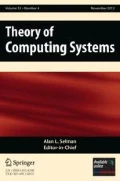Abstract
A random access machine model that has capabilities for parallel processing and string manipulation is introduced. It is shown that NP is equal to the class of sets accepted by this model in nondeterministic timeO(logn), that PSPACE is equal to the class of sets accepted by this model in deterministic polynomial time and thatP is equal to the class of sets accepted by a restricted version of this model inO(logn) space. These results generalize to arbitrary time and storage bounds.
Similar content being viewed by others
References
A. Aho, J. E. Hopcroft and J. D. Ullman,The design and analysis of computer algorithms, Addison-Wesley, Reading, Massachusetts (1974).
A. K. Chandra, D. C. Kozen and L. J. Stockmeyer, Alternation,JACM 28 (1981), 114–133.
S. A. Cook, Characterizations of pushdown machines in terms of time bounded computers,JACM 18 (1971), 4–18.
S. A. Cook and R. A. Reckhow. Time bounded random access machines,JCSS 7 (1973), 354–375.
P. W. Dymond, “Simultaneous resource bounds and parallel computation, Technical Report 145/80, Dept. of Computer Science, Univ. of Toronto (1980).
S. Fortune and J. Wyllie, Parallelism in random access machines,Tenth ACM Symposium on Theory of Computing, San Diego (1978), 114–118.
L. M. Goldschlager, A unified approach to models of synchronous parallel machines,Tenth ACM Symposium on Theory of Computing, San Diego (1978), 89–94.
J. Hartmanis. Computational complexity of random access stored program machines,Math. Systems Theory 5 (1971), 232–245.
J. Hartmanis and J. Simon, On the power of multiplication in random access machines,Proc. of the 15th Annual IEEE Symp. on Switching and Automata Theory, New Orleans (October 1974), 13–23.
J. E. Hopcroft and J. D. Ullman,Introd. to Automata Theory, Languages and Computation, Addison-Wesley, Reading. Massachusetts, 1979.
V. R. Pratt and L. J. Stockmeyer. A characterization of the power of vector machines,JCSS 12 (1976), 198–221.
W. J. Savitch, Recursive Turing machines.Intern. J. Computer Math 6 (1977), 3–31.
W. J. Savitch, Parallel and nondeterministic time complexity classes,Automata, Languages and Programming, Fifth EATCS Colloquium, Udine, Italy (1978), 411–424.
W. J. Savitch and M. J. Stimson, Time bounded random access machines with parallel processing.JACM 26 (1979). 103–118.
Author information
Authors and Affiliations
Additional information
A preliminary version of some of these results was presented in [13]. This research was supported, in part, by NSF Grants MCS-74-02338 and MCS-8001963.
Rights and permissions
About this article
Cite this article
Savitch, W.J. Parallel random access machines with powerful instruction sets. Math. Systems Theory 15, 191–210 (1981). https://doi.org/10.1007/BF01786979
Received:
Revised:
Issue Date:
DOI: https://doi.org/10.1007/BF01786979




